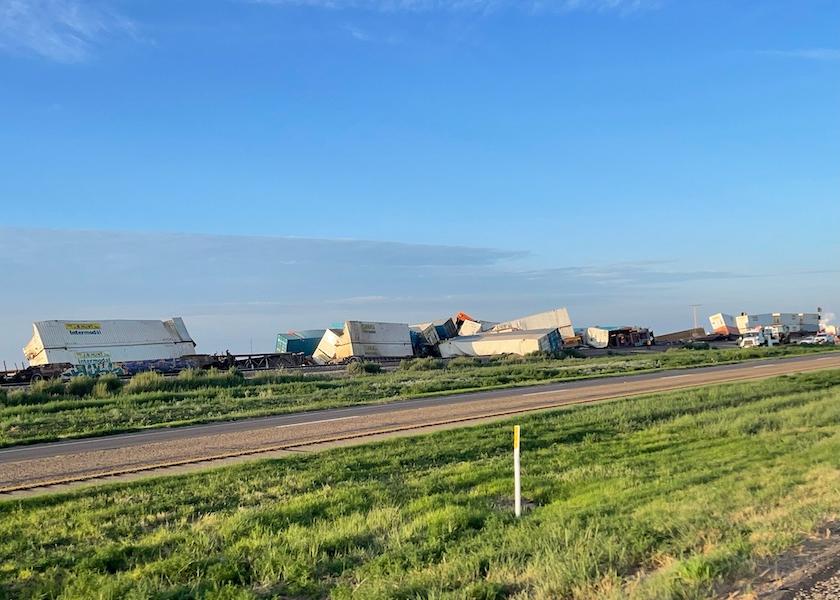The U.S. is Now 30 Days Away From a Possible Railroad Labor Strike

Delays on U.S. railroads have been a growing problem for shipping agricultural goods all year. Labor discussions are ongoing and with the grain industry concerned about a possible labor stoppage in mid-September, which would be the height of Midwest harvest.
Just this week, the White House-appointed Presidential Emergency Board (PEB) released a recommendation as part of the ongoing collective bargaining process. Both sides have 30 days to accept those recommendations. If the two parties don't agree, then rail workers are allowed to go on strike as of Sept. 16.
Max Fisher, Chief Economist, National Grain and Feed Association (NGFA) has been watching the situation closely. He says the biggest takeaway from the Emergency Board’s recommendation is a 24% wage increase over five years for rail labor.
"You may be asking, 'Where does that stand with respect to where the two sides were at?' The rail carriers were at 17% for what they were offering, and rail labor, what they were requesting, was 31%. So, 24% is right in between those two figures," says Fisher.
Congress Holds the Power to Intervene
While workers can legally go on strike starting Sept. 16 if they don't choose to adopt the board's recommendations, Congress can intervene if workers decide to strike Sept. 16.
"If history repeats itself, the last time we had a stoppage was in the early 1990s," he says. "And I believe it lasted one day, maybe two days, before Congress passed a bill prohibiting a lockout or strike. Essentially, the two sides had to then go back to work on reaching agreement. So, Congress has a lot of power here. We would like to think they're going to exercise it, and we're certainly going to encourage them to exercise it because stopping the railroads would be very, very bad for the agricultural economy."
Fisher says the railroads have been working to hire more workers, but considering the current labor shortage and shipping delays, he expects rail delays to last another year. The rail delays have been so bad, some feed users report being just days away from running out of feed. Those delays could be inevitable even if a strike is averted in September.
Trouble Shipping Grain And Feed Via Rail Far From Over, Concerns Now Growing About Possible Worker Strike At Harvest
"Obviously, it could get worse if the trains were just to completely stop. But the service right now, even without a stop, is just not the best," says Fisher. "There's still a lot of delays as far as bringing rail cars to facilities, pulling them and delivering them. So, now the grain industry is still not in a good spot with respect to rail transportation."
Tense Labor Negotiations
The April hearing in front of the STB gave a hint to how tense those labor negotiations could continue to be. Rail carriers pointed out how severely impacted they’ve been from what’s been dubbed the “Great Resignation,” and the issues getting labor back up to speed. Certain rail carriers also outlined the plans in place to get labor back to necessary levels to operate efficiently and smoothly.
However, rail workers place blame on the railroads, saying there’s more to the story. Mark Wallace, locomotive engineer, and vice president of Brotherhood of Locomotive Engineers and Trainmen (BLET), North America’s oldest rail labor union, testified during the STB hearing in April.
“Since 1984, 40 railroads have been reduced to seven class one carriers, now largely controlled by speculators and hedge fund investors,” he stated. “This culture of profits over safety, customer service and the lives of railroad workers, is now exposed as this network fails on a daily basis.”
Union Pacific, which is also part of the labor negotiations between rail workers and freight railroads over a new labor contract, signaled in July that the two sides were still far from reaching an agreement.
"I wish we could have gotten an agreement earlier in the process," Union Pacific's Lance Fritz said. "But the railroads and the union leadership are pretty far apart right now in terms of what we think is an appropriate settlement on wages."
The talks involve nearly 115,000 union rail workers and more than 30 railroads and started in 2020.
BNSF Train Derails This Week
A BNSF train derailed between Hereford, Texas, and Dawn, Texas, early Wednesday morning. While the cause is still unknown, on-the-ground reports say pieces of the track were scattered around where the rail cars derailed and piled up.
Photos showed the aftermath of the accident. Sources from around the Hereford area describe that part of the rail line as extremely busy, with a train passing through that spot nearly every 15 minutes.
"BNSF can confirm that at approximately 5 a.m. CT, an eastbound intermodal freight train derailed 17 cars northeast of Hereford, Texas," a BNSF communications spokesperson told Farm Journal. "There were no injuries to the train crew. Our teams are on site with equipment to clear the area and restore the track. The estimated time to reopen our first main train is mid-afternoon. The cause of the derailment is under investigation."
@tyne_agtv Train derailment outside of Hereford, Texas early this morning. BNSF confirmed 17 cars derailed and says cause is under investigation. #train #derailment #railroad #agriculture #supplychainissues ♬ Oh No - Kreepa
Maps of BNSF routes shows that specific line runs as far west as California, evening leading the Port of Los Angeles, a port known as one of the world's busiest seaports and a leading gateway for international trade in the Western Hemisphere.
Derailments have been a concern for grain shipping industry experts, especially considering the high heat in the South and Southwest this year. The triple digit heat could cause railways to buckle.








